about
- bio
- resume
- statement
- reviews
Olivia Bernard is a visual artist who has exhibited at galleries and museums in New York and New England, including the Smith College Museum of Art, the Rose Art Museum, the Bell Gallery at Brown University, the Currier Gallery of Art, the Springfield Museum of Fine Arts, Marymount Manhattan College in New York City, and the Brattleboro Museum and Art Center. She has also been a recipient of a Massachusetts Artists Fellowship. She received her BA in Art History from Brown University and her MFA in Sculpture from the School of the Museum of Fine Arts, and Tufts University, Boston, MA. She has taught sculpture at numerous colleges in the northeast including the School of the Museum of Fine Arts Boston, M.I.T., and Amherst College. She divides her time between Western Massachusetts and New York City. Her practice includes sculpture, installation and drawing.
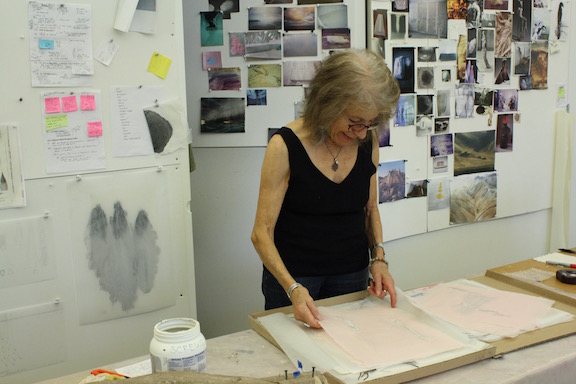
Solo, Two and Three Person Exhibitions
2022
Stoneleigh-Burnham School, Greenfield, MA
Launchpad, Boston Sculptors Gallery, Boston, MA
2017
What Lies Between, (solo), Oresman Gallery, Smith College, Northampton, MA
(Dis)Entanglement, UMass Five College Credit Union, Hadley, MA
2012
Species and Underpinnings, (solo), Gallery A3, Amherst, MA
2011
Three Seeing, A.P.E. at Window, Northampton, MA
2008
New work, Amherst Art Alliance, Amherst, MA
2007
Thoughts and Notations, Amherst Art Alliance, Amherst, MA
2006
Hewitt Gallery of Art, Marymount Manhattan College, New York, New York
2005
MPG Contemporary, Boston, MA
2003
Descent and Flight: Terra Incognita, Hampden Gallery, University of Massachusetts, Amherst, MA
2002
Collaborative Movement Installation, New York, NY
1996
Kunstforum Troadkastn, Kramsach, Tirol, Austria
Smith College Museum of Art, Northampton, MA
1994
Arno Maris Gallery, Westfield State College, Westfield, MA
Eli Marsh Gallery, Amherst College, Amherst, MA
1992
The Space, Boston, MA (solo installation/two person show)
1989
Museum of Fine Arts, Springfield, MA
1988
Gallery Eleven, Tufts University, Medford, MA
1985
Hillyer Gallery, Smith College, Northampton, MA
1984
Noel Butcher Gallery, Philadelphia, PA
1982
Pratt Gallery, Amherst, MA
Selected Group Exhibitions
2022
60 Years of Collecting, University Museum of Contemporary Art, Amherst, MA
2021
Looking Forward, Carter Burden Gallery, New York, NY
2020
Hues of Blue, Amherst Art Alliance, Amherst, MA
2019
Hallspace Drawing Project, Hall Space, Dorchester, MA
Red Dot Dash, APE Galleryu, Northampton, MA
2018
Thread Up: Challenging "Women's Work" from 1960 to Present, Virtual Exhibition (https://blogs.umass.edu/arthist391a-kurczynski-2/2018/03/29/test-post/), courtesy of University Museum of Contemporary Art, Amherst, MA
Drawing As A Verb, University Museum of Contemporary Art, Amherst, MA
2017
Uncommon Goods-String Holders, Race St. Gallery, Holyoke, MA
Drawing Connections, University Museum of Contemporary Art, Amherst, MA
2016
Take a Seat, University Museum of Contemporary Art, UMass, Amherst, MA
2015
Microworks, APE, Northampton, MA
Twice As Good, Boston Sculptors Gallery, Boston, MA
The Book Show, Taber Gallery, Holyoke, MA
Across the River, Oxbow Gallery, Northampton, MA
Nothing Is Wasted, Amherst Art Alliance, Amherst, MA
2012
Amherst Biennial, Amherst, MA
In The Round, Victory Theater, Holyoke, MA
10th Anniversary Exhibition, Amherst Art Alliance, Amherst, MA
Group Exhibition, Deerfield Academy, Deerfield, MA
Hidden in Plain View, Paper City Gallery, Holyoke, MA
2010
In-Dialogue, Amherst, MA
2009
A3 Shows Up at STCC, Springfield Tech. Community College, Springffield, MA
2008
Invitational, Northampton Center for the Arts, Northampton, MA
Who We Are, Barnes Gallery, Leverett, MA
Wrap it UP, University Gallery, University of Mass, Amherst, MA
Americaura, National Library of Camaroon, Camaroon, West Africa
2007
Americaura, University of Massachusetts, Amherst, MA
Summer Sculpture Show, MPG Contemporary, Boston, MA
2006
Non-Objective Works on Paper, Nicholas F. Rizzo fine Arts, Inc. Chatham, NJ
RX Art Ball Auction, New York, New York
2005
Arts of the Valley Celebration Exhibition, Open Square, Holyoke, MA
In the ZONE, Bridget Moore, DC Moore Gallery, NYC, Juror, Brattleboro Museum And Art Center, Brattleboro, VT
In and Around Us, Bell Gallery, List Art Center, Brown University, Providence, RI
A3 Again, Northampton Center for the Arts, Northampton, MA
Three Views, Amherst Art Alliance, Amherst, MA
2003
International Sculpture Ctr Juried Exhibition, Grounds for Sculpture, Hamilton, N
Conversations: Four Sculptors, Gallery A, Amherst, MA
2002
New Members Show, Gallery A, Amherst, MA
2001
Dressed for Success, Canal Gallery, Holyoke, MA
1998
Group Exhibition, Canal Gallery, Holyoke, MA
1997
Recent Works of Building Artists, Canal Gallery, Holyoke, MA
1995
Six Artists, Nacul Gallery, Amherst, MA
Cast of Six, Lamont Gallery, Phillips Exeter Academy, Exeter, NH
Drawering Show, Springfield Technical College Springfield, MA
Bay State: Artists of the Pioneer Valley, Krasdale Foods Art Gallery, New York, NY
Nature/Culture, Nacul Art Gallery, Amherst, MA
1994
Sensitive Material, Arno Maris Gallery, Westfield State College, Westfield, MA
Inside Out, Starr Gallery, Newton, MA
1993
Cast of Seven, The Art Complex Museum, Duxbury, MA
1992
Contemporary Art from the Permanent Collection, Rose Art Museum, Brandeis University, Waltham, MA
Contemporary Sculpture at Chesterwood, Trevor Fairbrother, Juror, Chesterwood Museum, Stockbridge, MA
Distinct Voices, Joyce Kozloff, Juror, Federal Reserve Bank Gallery, Boston, MA
1991
Berkshire Art Association, Jock Reynolds, Juror, Berkshire Museum, Pittsfield MA
New Artists: The Gloria Wilcher Memorial Exhibition, Currier Gallery of Art, Manchester NH
1990
Body Works –– Points of Departure, Ethan Karp, Juror, Artworks Gallery, Hartford, CT
Faculty Exhibition, School of the Museum of Fine Arts, Boston, MA
New England Women, Howardena Pindell, Juror, Northampton, MA
1989
Allusion/Dimension, The Lois Foster Exhibition of Boston Area Artists, Rose Art Museum, Brandeis University, Waltham, MA
Four Sculptors, The Space, Boston, MA
Inner Spaces, Robert Rohm, Juror, Hera Gallery, Wakefield, RI
1988
New Work, Bonnie Grad, Patricia Johnston, Nancy Stapen, Jurors, Winfisky Gallery, Salem State College, Salem, MA
Sculpture Annual, School of the Museum of Fine Arts, Boston, MA
1987
Fort Point Channel Artists, Kathy Halbreich, Marge Jacobsen, John McNamara, Jurors, Federal Reserve Bank, Boston, MA
Sculpture Annual, School of the Museum of Fine Arts, Boston, MA
1986
36/86 –– A Group Show, Wisteriahurst Museum, Holyoke, MA
1984
Local Color, New Faces, Summer Invitational, Clark Gallery, Lincoln, MA
Divine Vistas, Noel Butcher Gallery, Philadelphia, PA
1983
Berkshire Art Association 1983 Painting/Sculpture Exhibition, Patterson Sims, Juror, Berkshire Museum, Pittsfield, MA
Review/Preview, Noel Butcher Gallery, Philadelphia, PA
1982
Summer Exhibition, Clark Gallery, Lincoln, MA
Young Artist Exhibition, Provincetown Art Association and Museum, Provincetown, MA
1981
Gallery Artists, Pratt Gallery, Amherst, MA
Group Exhibition, ZONE Gallery, Springfield, MA
1980
Combinations, Danforth Museum, Framingham, MA
Collage, Watson Gallery, Wheaton College, Norton, MA
Fellowships, Awards, Residencies
2010
Residency in Paper Making, Women’s Studio Workshop, Rosendale, NY
2006
Residency, Vermont Studio Center, Johnson, Vermont
1992
Residency, Cummington Community of the Arts, Cummington, MA
1991
Massachusetts Artists Fellowship, Sculpture, Artists Foundation, Boston, MA
Nominated for Awards in the Visual Arts 11, Southeastern Center for
1990
Contemporary Art, Winston-Salem, NC
1989
Merit Award, New England Women Exhibition, Northampton MA
1987
Massachusetts Arts Lottery Grant for Women’s Caucus for Art, Northampton, MA
1986
Sculpture Prize, School of the Museum of Fine Arts, Boston, MA
Tobeleah Wechsler Annual Award in Drawing, Cheltenham Art Center, Philadelphia, PA
1985
Tuition Scholarship, Tufts University, Boston, MA
Semi-Finalist, Massachusetts Artist Fellowship Program, Boston, MA
1984
Massachusetts Arts Lottery Grant, South Deerfield, MA
1973
First Prize, Card Design Competition, Museum of Fine Arts, Boston, MA
Education
M.F.A., Sculpture, Tufts University / School of the Museum of Fine Arts, Boston, MA
M.E.D. Lesley College Graduate School of Education, Cambridge, MA
B.F.A. Equivalency, Painting, School of the Museum of Fine Arts, Boston, MA
B.A., Art History, Brown University, Providence, RI
Vermont Studio School, Johnson, VT
University of Massachusetts, Sculpture Department, Amherst, MA
Maryland Institute of Art, Baltimore, MD
Teaching
2020
Outside Evaluator, Marlboro College, Marlboro, VT
2016
Outside Evaluator, Marlboro College, Marlboro, VT
2015
Artist MFAWC Graduate Program, Mass College of Art, Boston, MA
2011
Artist Teacher, Vermont College of Fine Arts, Norwich, VT
2010-2011
Private Teaching, Leverett, MA
2008-2009
Artist/ Mentor, MFA in Visual Arts, AIB at Lesley University, Boston, MA
2007-2008
Artist/Lecturer, MFAWC Graduate Program, Mass College of Art, Boston, MA
2006
Outside Evaluator, Marlboro College, Marlboro, VT
2005
Senior Evaluator, Marlboro College, Marlboro, VT
2004
Visiting Artist, Julliard School, New York, New York
1995-04
Private Teaching and Mentoring
1998
Visiting Artist, Marlboro College, Marlboro, VT
1994
Visiting Assistant Professor of Art, Mt. Holyoke College, South Hadley, MA
Sculpture Faculty, Amherst College, Amherst, MA
Master of Fine Arts Artist/Teacher, Vermont College of Norwich, Montpelier, VT
1994-1995
Division III Committee Member, Hampshire College, Amherst MA
1993
Lecturer in Sculpture, Massachusetts Institute of Technology, Cambridge MA
1992
Winter Term Instructor, Hampshire College, Amherst, MA
1990-1991
Associate Instructor of Sculpture, Master of Fine Arts Candidate Advisor, School of the Museum of Fine Arts, Boston, MA
1986-1987
Teaching Assistantship, Sculpture, with Mags Harries, School of the
Visiting Artist, Massachusetts College of Art, Boston, MA
Visiting Critic, Vermont Studio Colony, Johnson, VT
Adjunct Lecturer, Sculpture, Boston College, Newton, MA
Visiting Artist, Education Program, Museum of Fine Arts, Springfield, MA
1988-89
Sculpture Faculty, School of the Museum of Fine Arts, Boston, MA
Museum of Fine Arts, Boston, MA
1973
Teaching Assistantship, Painting, School of the Museum of Fine Arts, Boston, MA
Public Lectures
2017
UMass Five College Credit Union, Hadley, MA
Private Salon, Florence, MA
2015
Art Salon, University of Massachusetts, Amherst, MA
2012
Hillside Salon, University of Massachusetts, Amherst, MA
2011
Snow Farm, Williamsburg, MA
2007
Artists on Art, Smith College Museum of Art, Northampton, MA
2003-2004
Salon Program, Gallery A3, Amherst, MA
2003
Hampden Gallery, University of Massachusetts, Amherst, MA
2001
Guild Studio School, Northampton, MA
1999
Marlboro College, Marlboro, VT
1996
Smith College Museum of Art, Northampton, MA
1994
Westfield State College, Westfield, MA
1993
Starr Gallery, Newton, MA
1992
The Space, Boston, MA
1989
Museum of Fine Arts, Springfield, MA
Rose Art Museum, Waltham, MA
Bibliography
Interview with Elizabeth Michelman, Artscope, Septempber/October 2017
Creating Abstract Art: Ideas and Inspiration for Passionate Art-Making, Dean Nimmer Cincinnati: North Light Books, 2014, pp. 32, 33.102.
Review, Sandra Dias, The Republican, and Masslive.com, January 2013
Review/profile, Amherst Bulletin, Amherst, MA 2008
Review, Daily Hampshire Gazette, Northampton, MA, May 2007
Review, Boston Globe, by Cate McQuaid, July 2005
Review, Sculpture Magazine, July/August 2004
Review, Art New England, April, 2004
Review, Daily Hampshire Gazette, November 2003
Review, Springfield Sunday Republican, November, 2003
Review, Springfield Sunday Republican, February 2003
Review, Daily Hampshire Gazette, February 2003
Review, Springfield Sunday Republican, May 2002, Springfield, MA
Review, Greenfield Recorder, May 2002, Greenfield, MA
Critics Tip, Boston Globe, February 1996, Boston, MA
Preview, Daily Hampshire Gazette, January 1996, Northampton, MA
Review, Springfield Sunday Republican, February 1996, Springfield, MA
Interview, Smith College Museum Newsletter, Winter 1996, Northampton, MA
Review, Art New England, June 1996, Waltham, MA
Review, Springfield Sunday Republican, November 1994, Springfield, MA
Review, Daily Hampshire Gazette, November 1994, Northampton, MA
Review, Springfield Sunday Republican, March 1994, Springfield, MA
“Inside/out,” Exhibition Catalog, Starr Gallery, September 1993, Newton, MA
Review, Springfield Sunday Republican, September 1993, Springfield, MA
Review, Springfield Sunday Republican, September 1992, Springfield, MA
Review, Springfield Sunday Republican, August 1992, Springfield, MA
“Contemporary Sculpture at Chesterwood,” Exhibition Catalog, 1992, Stockbridge, MA
Review, Art New England, August 1992, Waltham, MA
Review, Art New England, February 1992, Waltham, MA
“New Artists 1991,” Exhibition Catalog, The Currier Gallery of Art, Manchester, NH
Arts Watch, Valley Advocate, September 1991, Hatfield, MA
“1991 Exhibition of Painting and Sculpture,” Exhibition Catalog, Berkshire Museum, Pittsfield, MA
Review, Springfield Sunday Republican, September 1991, Springfield, MA
“At the Rose Art Museum: The Art of Our Time,” Brandeis Review, Winter 1990
“Allusion/Dimension,” Exhibition Catalog, 1989, Rose Art Museum, Waltham, MA
Review, Boston Sunday Globe, December 1989, Boston, MA
Review, Boston Herald, November 1989, Boston, MA
Review, Art New England, July 1989, Waltham, MA
Review, Springfield Sunday Republican, June 1989, Springfield, MA
This Way Daybreak Comes: Women’s Values and the Future by A. Cheatham and M. C. Powell, New Society Publishers, 1986
Interview, Charlene Koh, WFCR FM Radio, May 1985, Amherst, MA
Review, Springfield Sunday Republican, May 1985, Springfield, MA
Review, Philadelphia Enquirer, April 1984, Philadelphia, PA
Review, Art New England, June 1982, Waltham, MA
Review, Springfield Sunday Republican, May 1982, Springfield, MA
Exhibition Catalog, Watson Gallery, Wheaton College, February 1980, Norton, MA
Private Collections
Janice Oresman, New York, NY
Jan F. Golann, New York, NY
Nancy and Bruce Goldstein, Northampton, MA
Jane Kristal, Amherst, MA
Nan Niederlander, Leverett, MA
Sheron Rupp, Haydenville, MA
Beverly Floyd, Zurich, Switzerland
Mr. and Mrs. George Katz Jr., Brookline MA
Mr. and Mrs. Samuel Osherson, Cambridge MA
Dr. R. G. Monroe, Westwood MA
Paul Hertz and Jamie Rauchman, New York, New York
Alois Schild and Brigitte Meunier, Kramsach, Austria
Michael Geiger, Kramsach, Austria
Amy Lippman, Atty., New York, NY
Peggy and Nick Kaufman, Newton, MA
Dr. Patricia Everett, Amherst, MA
Timothy Rivinus, M.D, Providence, RI
Anne Ellsworth, Cambridge, MA
Larry Smith and Anne Mochon, Amherst, MA
Public Collections
University Museum of Contemporary Art, University of Massachusetts, Amherst, MA
Rose Art Museum, Brandeis University, Waltham MA
William F. Smith, Jr. A.I.D., Philadelphia PA
Shaun F. O’Malley, CPA, Philadelphia PA
Edward Friedman, Atty, Springfield, MA
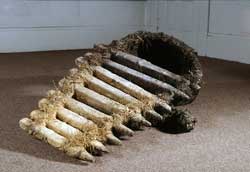
Untitled (with Stairs), 1990
hydrocal, wood, wire, pigment, hay
30" x 24" x 35"
Recent life events–personal, as well as the immense number of troubling world events–have led me to focus on the intangible issues of presence, absence, loss, and death. The work also raises questions of what is real and touchable, what is ungraspable or evanescent. Sheer papers, sewn, stretched, perforated, pinned; skeletal constructions, dipped repeatedly in baths of pulp; plaster stupa-like forms embedded with glass, rusty wires and rods hung with cloth and paper, all emerge as signifiers for this subject matter.
I have been exploring these issues in several series simultaneously: small drawings on mylar; wall pieces with wax and handmade paper and thread on glass sheets; sheer handmade paper pieces embedded with threads and tissue; and installations which use these elements in an accumulated form. In addition, I am revisiting forms from earlier work, such as long wood poles, and solid plaster forms, to rethink their relationship to my
current work process.
This variety of forms enables me to examine the extremes of life’s
continuum from dense corporality to utter fragility. I move from the
sculpture, whose physical presence is solid, fleshy, volumetric, and
gravity bound, to the drawing images, which portray ambiguous forms
both solid and translucent, to the paper, so thin and delicate that it is
barely there. The experience of these works together conveys varying
degrees of presence, absence, rupture, mending, becoming and
disappearing.
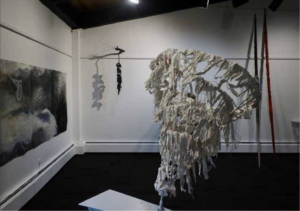
ARTSCOPE MAGAZINE
November/December 2022
AN INNER SENSE OF WHOLENESS
Click to download a PDF of the reviewOlivia Bernard’s exhibition of sculpture and two-dimensional work spreads out under the sloping roof of The Stoneleigh- Burnham School’s Geissler Gallery. Hanging sheets of white scrim bound the space on one side, separating her work from that of another well-known installation artist, Karen Dolmanisth.
Bernard’s self-curated selections, which span her output of the last 26 years, combine earlier with later works to propose more of a gist than a direct path connecting the lot. Each sculpture demands enough space that, when one is in its presence, the next one hovering nearby does not impinge on one’s sense of being alone with another being. Each piece holds its own, capturing the viewer’s attention and indeed anxiety. As with Giacometti’s figures, one finds that on more intimate approach the works feel larger and more charged.
The abstract work is grounded in cumulative experiences of aging and loss, tempered by an awareness of the sufferings of our times. While Bernard’s immediate audience is adolescent schoolgirls, she addresses all ages in her emphasis on the grounding of awareness and imagination in bodily-based experience.
Despite their sometimes-ungainly Bernard’s forms are deeply human constructions that lead one to engage with internal signals, dialogue and a sense of one’s own existential condition. Many works are built around stiff armatures, using some combination of muslin, cheesecloth, wood, wire, glass and paper that Bernard dips or embeds in Hydrocal, a modifiable type of plaster. Rather than painting her surfaces, she integrates pigments and dyes into her materials’ natural textures, running a gamut from velvet black to gleaming white, with dirty smears of rust or grey and the occasional splash of forgotten blue.
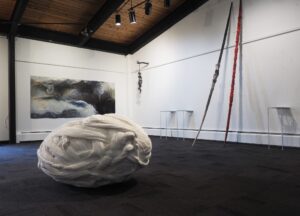
Sculpture
November 10, 2022
Olivia Bernard
Click to download a PDF of the reviewGreenfield, Massachusetts
Geissler Gallery at Stoneleigh-Burnham School
The work of Olivia Bernard, a longtime contributor to the New England and New York art scenes, commands the power to surprise and fascinate. The abstract, human-scale sculptures featured in “Visual Cycles • empty/full • absence/presence,” a two-person show with Karen Dolmanisth (on view through November 18, 2022), exude a compelling aura in the gloom of the shed-like Geissler Gallery. Each piece projects anxiety in the visible effort to maintain equilibrium in relation to gravity—rolling on the floor, balancing on a table, propped against the wall, or suspended from the rafters. A second body of work explores the spatial ambiguities of two-dimensional form with a decided sculptural twist.
Bernard has always been attracted to materials that transform from a fluid to a frozen state—first Hydrocal and Rhoplex; more recently, paper-pulp slurry and molten wax. She pours, casts, or layers these materials over an armature, combining hard and soft materials into an expressive and mysterious result. In her recent two-dimensional work, plate glass (an arrested liquid) becomes a substrate for dimensional materials interacting with the picture plane.
Working by hand with alchemical processes and simple tools, Bernard submits her materials to the bidding of her unconscious and the force of gravity. Immersed in constructing form, she lets instinctual energies take over and guide her in the moment. Something of this altered state is conveyed through the work.
“Visual Cycles” includes seven large, mixed-media and Hydrocal sculptures and six smaller hybrid works that highlight the optical and physical properties of glass sheets. Both bodies of work reveal Bernard’s growing preoccupation over the past two decades with the polarities of darkness/ lightness, gravity/air, and gravitas/transcendence. The most recent works are radiant with clarity, pain, and triumph.
Bernard repeats gestures of wrapping and twisting paper in earlier and more recent works to produce striking spiral-based forms. Untitled (Large Ovoid) (1996) is a paper-bound egg that might imprison a curled-up human. The ribs of Spin (2020–22), a wheeling vortex of soldered steel, are wound in paper strips dripping with stiffened Hydrocal. The spiral also appears in Untethered (2004), an atmospheric, nine-and-a-half-foot drawing studded with whirlwind shapes. It provided a take-off point for several room-size installations—swirling accumulations of airborne curvaceous forms. Billow (2005) more compactly mirrors similar forces in its suspended wave of curled plaster fragments.
From the transitional Untitled (Pillow 3) (1994–2015), a puffy plaster square framing a glass pane, Bernard’s interest in glass took her to the shadowy intersections of flat and dimensional form. Pursuing investigations with handmade paper, paper pulp, glass, and poured wax, she found new possibilities of luminosity and translucence. Seeing Through, from the 2014 “Glass” series, is small glass panel leaning against the wall on a close-fitting steel shelf. A spill of wax covers and cements a string and a sheet of hand-pressed abaca to the panel, leaving exposed many details from the front and back of the picture plane and beyond.
In the current series, “Abhasas,” Bernard lays doubled, unframed glass panes atop delicately crafted steel stands, barely overlapping the edges of the empty upper rectangle. Sandwiched between each pair of panes lies a collage of handmade paper, abaca, thread, and strips of Dura-Lar, held together by gravity. One of these pieces displays a cloudy, fragmented news photo of a bombed-out apartment building in Ukraine.
The pandemic years accelerated a process of inward turning and reflection on aging and loss. They also sent Bernard back to her first love, plaster. From this familiar source, ominous and unstable forms have emerged, including the wraith-like Spin and the all-black Gnarl, an abstracted limb that reaches out from the wall, as if tempting the viewer to grasp its spray of dark, desiccated pods. Pain may never be far from the surface.
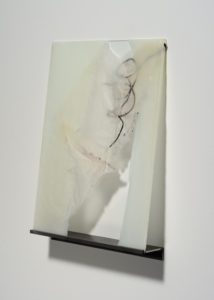
Artscope Magazine
September/October, 2017
Cornered: Olivia Bernard
Click to download a PDF of the reviewOlivia Bernard’s sculpture has always spoken through the fingertips to the whole body. No matter how flat a piece becomes, there’s always another side — and always a sense of inside and outside. It’s tempting to read her small glass panels and attenuated sheets of handmade paper as following within the traditions of abstract or color field painting. But Bernard is neither a painter nor a follower and has no interest in carrying forward the ideological, political or art-historical agenda of abstract painting today. Her 3-D sculpture and installation is grounded in minimalism, feminism and process art. Drawing has always been an extension of her 3-D exploration; she approaches the surface not as a field of visual experimentation but as an exploration of her personal boundaries.
In October, at Smith College’s Brown Fine Arts Center, Bernard will be showing two groups of smaller, relatively flat, wall-mounted work. These employ simple, low-tech materials, as usual, to explore the sensation of translucency. As in her larger sculptures and installations, which have shifted from poured Hydrocal carapaces to handmade paper over wire mesh, the materials in the current works are vitalized in an alchemical transformation from liquid to solid. The “Glass/Wax” series involves a process of dipping glass panes in hot wax, while the “Embedded” series fixes linear structures into stable forms in wet paper pulp.
The materiality of Bernard’s works forces us to reconsider our notions of both “flatness” and “drawing.” Her avoidance of traditional frames forces us to see these forms, in spite of their thinness and rectilinearity, as objects. In the “Glass/Wax” series, the work is not hidden behind glass; the glass pane, which serves as both surface and structure, is itself the work. Leaning against the wall and supported only by a narrow steel flange, each naked pane is at risk from vibration and mishandling. Likewise, Bernard refuses to confine the handmade paper sheets of the “Embedded” series. She floats them over an invisible Plexiglas substrate projecting a few inches off the wall, where they are subject to air currents, gravity, and electrostatic attraction.
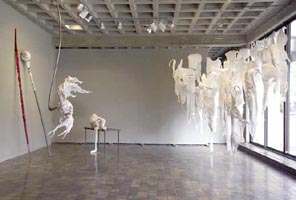
Art New England
April/May 2004
Olivia Bernard: Descent and Flight: Terra Incognita 2003
Click to download a PDF of the reviewOn a visceral level, her work captures the dualities of death and life, sorrow and joy, bondage and freedom. …a feeling of subjected consciousness, wavering between the ephemeral dreamlike meanderings of the mind and the physical limitations of reality.
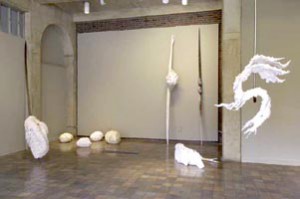
Sculpture Magazine
July/August 2004
Hampden Gallery/UMASS Amherst
Click to download a PDF of the reviewOn a visceral level, her work captures the dualities of death and life, sorrow and joy, bondage and freedom. …a feeling of subjected consciousness, wavering between the ephemeral dreamlike meanderings of the mind and the physical limitations of reality.
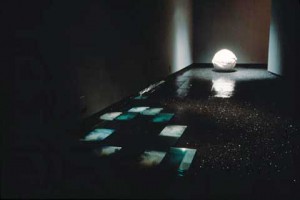
Smith College
June/July 1996
Essential Forms and Migrations
Bernard inquires into the nature of, and the connections among, all living things, the spiritual component that underscores the life force. This installation inspires both pleasure and anxiety: transitions from light to darkness are as compelling as they are frightening; familiar forms captivate and confuse; its sandy path both guides and troubles us.
Boston Globe
1996
Bernard shows new sculpture
Olivia Bernard, a gifted sculptor who divides her time between Northampton and New York, is showing a new installation, through March 17, at the Smith College Museum of Art. Inspired by a hiking trip in the Swiss Alps,‘Essential Forms and Migrations’ is an enigmatic, intriguing work that suggests emotional as well as physical transition. It carries the, visitor through a dimly lit space mapped by architectural plaster and wire divisions, punctuated by abstract objects. Bernard’s mysterious forms conjure nature, as with a large ovoid shape composed of a continuous swathe of white paper knotted around a hidden core, reminiscent of an egg, seed or pod. The work’s blue, black and white palette evokes a frosty mountain environment, with scattered’ pools suggesting the glacier basin.
Art New England, The Currier Gallery of Art
1992
The 3rd Gloria Wllcher Memorial Exhibition
Curator Michael Komanecky has selected artists currently living in New England whose accomplishments deserve the attention of a wider audience creating an impressive exhibition of primarily large-scale works. Olivia Bernard Wilson’s powerful sculptures depict violence, grief, and decay. In Keening, wire, wood. rhoplex, cheesecloth, Hydrocal, and pigment are transformed into a post-industrial wraith. The dark, bulky, hollow form appears to be caught, mid-air, in a ritualistic flight of mourning.
Another untitled work [untitled, “Containment II”], constructed of similar materials but filled with sand and straw and hanging heavily on a wooden frame, conjures up a beheaded and disintegrating animal in an abandoned slaughterhouse or gallows. The influence oi Louise Bourgeois is apparent in these sculptures-unattractive but alluring forms exploring messy human conditions and emotions.
Boston Globe
1989
“The physicality of sculpture, its potential for extremes of fragility and weight, is a means for examining (complex) experiences.” (Olivia Bernard Wilson)
Wilson’s four monumental pieces suggest hammocks, banners or litters, and her “Burden Bearer” involves ‘sagging billows of torn and pigmented cheesecloth where the layering of the material, the play of gravity, the contrast of the shapeless against the strict angles of the supports, explore the possibilities of complex tactile sensations.
Sunday Republican, Springfield, MA
June, 1989
Olivia Wilson has returned to the local scene from three years studying and teaching in Boston. As a result, her sculpture has changed in many ways. Mainly she seems interested in process as ‘much as in imagery.
“I’m always juggling those elements…thinking about how important is the original image I have in my head and how it transforms itself along the way.. .What happens along the way, and how do I incorporate that?” .
She uses plaster as her material, poured into and hardened over cloth. And her persistent theme is the relationship between the object and the support it requires during construction.
Plaster-covered poles suggesting those necessary in the actual transporting of “Transitional Bier” are components of the work. Not only do they recall part of the practical process of working on the piece, they also change the image from a body-like, container form. They imply “more about something being carried or borne.” They connote the process of change and transition.
In a monumental piece titled “Keening,” the armature has a spikey, aggressive quality which is in actual visual tension with the organic volumes of the plaster form. Without doubt the subliminal content here touches on issues of war and grief.
Through her creative procedure, Wilson engages in an internal dialogue in which she muses about social, political and art problems of our time. But paramount at the outset are issues of esthetic form. As Wilson says, “So much of (what happens to me is subconscious… I often set myself a formal problem… How long can I make this and have it still stand up, for instance, and it’s through that structure that the more emotional part comes through. I often don’t know what it really is about until it’s done.”
And the objects have any number of references. They assume all manner of allusions from nature, skin or bodies or landscapes. But first and foremost, the plaster, forms are containers, vessels that interact with space and with the imagination.
Plaster and lathing are fragile and impermanent materials; they suggest human vulnerability as well as mutability. And with the eventual form of the object dependent to some extent on gravity or atmospheric conditions, factors of process, the ambiguous forms imply “forces… beyond our control.”
Art New England
1989
The Space/Boston Four Sculptors
The stiffened fabric, large scale, and uneasy feel of Olivia Bernard Wilson’s forms bring to mind the work of Magdalena Abakanowicz, high praise indeed. Fishnet knotted to an overhead pipe dredges up From the Silence, a sinister dark shape about the size of a body bag. Rest is more or lees coffin shaped, sewn up like a flour bag, with a one-bag bump where we’d expect “head,” and, sure enough, a double-bag arrangement at the other end; all is coated with lumpy ochre colors like mud from a western grave. In the untitled work, fabric furled like a banner is hung from a lodgepole, its bellied folds stiff as if pregnant; deep in this womb, are scraps of straw scattered like a mouse nest, an articulating and effective detail. (Marty Carlock)
An ironic curatorial sensibility places these savage beings next to Olivia Bernard Wilson’s large hay structure. Wilson shares with Wales a view of nature calculated to make one uneasy. In In(e)Volution, this is achieved by making the structure larger than human scale and by placing small, membranous panels of latex into the installation wall. Revealed slowly on one’s journey through the maze, the panels resemble flayed flesh or insect pupae. At one entrance, it is surprising to discover that what one took for a gnaried branch is actually a large snake.
To this viewer, this installation seems more optimistic than Road Ruminant. It is a richly evocative work that casts nature in the role of muse and repository of human memory.